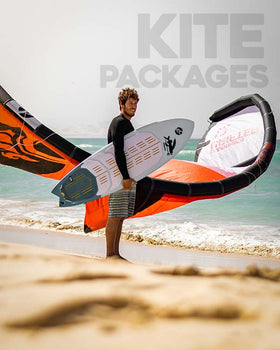
Sailing will make you a better Kiteboarder or Winger and here's why!
Technically speaking, kiteboarding and wing foiling are "sailing." When you harness the wind to generate speed and travel you are sailing. It can look like a variety of things, not only the archaic form of transportation the Vikings used. Kiteboarding and Winging are slightly different from traditional Sailing because the sails are designed and positioned differently, but the fundamentals are the same.
I was fortunate enough to go Sailing before I even started walking. It has made me more acclimated to the wind and water than I would have been without that privilege. I started competitively racing in Opti's (a cheap boat, looks like a bathtub, and kids learn to sail with it). I would practice in that silly little boat every week during the summer and on more fun boats with my family. Sailing makes you constantly pay attention to your surroundings and adjust to what the wind is doing at that current moment. The best way to describe it is that Sailing is where there are a few marks on the water, the sailor that wins the race imagines the course the best and sails it the fastest. I like to say that anyone can sail, but people with more sailing knowledge and experience can sail a little faster.
The key to reading the wind and water like a sailor is practice. Sailors spend much time looking upwind on the water, looking for puffs. A "Puff" is a burst of air that make you move faster or feel overpowered depending on the puff. The puffs do not happen randomly; you can see them and strategically use them. As you can see in the image below, they are visible on the water; you have to know what you're looking for on the water.
(Image courtesy of Richard C. Edwards' blog)
Experienced sailors spend more time looking for the wind and connecting the puffs, which keeps their speed up. When looking at the water, the very smooth areas have very little wind (sometimes the wind is higher off the ground and therefore invisible on the surface). The areas that look like a bunch of condensed ripples have more wind. Wind pushes the surface of the water, forming the ripples, and the direction they are flowing from tells you the wind direction. I have also heard a puff described as the aftermath of a bunch of invisible cats dancing on the water's surface. Another important note is that the darker the puffs appear, the more intense they will be. To hone the skill of seeing puffs and sensing their eta, sit by the water's edge and practice. Look for a darker patch of water with many lines on the surface, and count how long it takes to get to you; note the color, how windy it feels, and how long it lasts. The more you practice that skill, the easier it will be for you to understand their eta and intensity and better utilize the puffs.
The other important note about puffs is that putting yourself in the puff is not all that has to happen to go fast. There is a technique to maximize the puff's potential; the key is to depower a little before the puff hits to accommodate it and then power up. For example, suppose you are overpowered in a puff while riding upwind. You're likely going to slip sideways instead of track forwards. Slipping sideways ruins your "Velocity Made Good (VMG)," VMG is all about getting to your destination in the quickest, most direct fashion. Depowering and edging as hard as possible will prevent you from slipping.
Another aspect that would make someone sail faster is recognizing the favored tack or gybe. There are two different tacks, port, and starboard, and depending on what the wind is doing, one might be favored. What I mean by this is that sometimes one tack is more effective and should be used as the long tack and the other tack as a short tack. It all comes down to your upwind angle. The favored tack while going upwind is the one that allows you to point higher (sail closest to the wind without stalling), and when going downwind, it is the opposite. In a race, the person who recognizes which tack is favored and correctly hits the shift will be the fastest.
Recognizing a shift is a tricky concept, and it comes with practice. The good news is that you can feel it when it switches. Sometimes it happens slowly, where you can feel the angle you were once tracking become out of reach, which is called a "Knock" in the sailing world. Knocks have an inverse relationship with "Lifts," in which, if you tack on a Knock, you'll meet a Lift that will let you sail closer to the wind. Even the best sailors sometimes get out of sync with the wind. But, the key is to keep their head out of the boat and look around to nail the shifts.
A great example of this is at the start of a race. If sailors recognize the favored tack shift from starboard to port tack, they will be lifted starting on port and cross the entire fleet if the timing and spacing work.
(Video courtesy of Nick Reeves)
To port tack the fleet is one of the best feelings because it proves that you outsmarted most of your competitors by staying in tune with the wind. Being the first to notice the shift allows you to sail faster and at a better angle than your competitors until they follow your lead. As you can see in the video, Nick Reeves and Daniela Moroz make massive gains on their competitors because they are on the favored tack, and it is way easier to lead from the front because you have the cleanest air when you're in the lead.
What is clean air? I am not referring to air quality. I am referring to Clean air as that fresh virgin air that is stable and undisturbed. The disturbances in the wind, a building, a boat, and a kiter all could cause the pressure to be flooky and inconsistent. Dirty air is the most hurtful when the wind is light. Suppose you're a kiter and go out in borderline conditions. When somebody sails in the same lane, they become "windward" and will block you from getting clean air. The leeward kiter (rider further from the wind) is getting the dirty air off the windward kiter and is not as maneuverable. Notice that Nick and Daniela's kites are both on the favored tack, with their kites not on top of each other's, but they each have their lane keeping their air clean.
Being conscientious of the kiters and wingers around you is essential because we are all a part of the same community. I am not trying to lecture you and say you can't sail over people. All I am saying is to be conscientious of other riders and to pick your battles. Suppose you're an experienced kiter, and so are your good friends, and you want to park your kite right over theirs and mess with them. It's okay if it's safe and consensual. But, when an experienced kite covers a beginner, they can prevent them from generating power in their water start. It is a different story because you go directly upwind of their kite, disturbing it. After all, kiters, you want to be giving beginners ample space to learn and make mistakes. Learning is hard enough without experienced kiters refusing to tack earlier and dropping off some dirty air. Dirty air is the most detrimental to others in light air, but it decreases effectiveness as the wind increases. The concept of dirty air is the same for all sailors, with differences depending on pointing ability and sail shape.
Down here in Charleston, a strong current rips pretty much everywhere. The current around Charleston, South Carolina, is a fickle thing. Sometimes it can be misleading and make it look windier than it is. Suppose it looks windier on the water than on land. In that case, it's likely just the current opposing the wind and making the wave's crest earlier than it usually would. When a wave appears in deep water and white water forms at the top, it is white capping. It starts white capping around 10-12 knots (1 knot (KNT) is equivalent to 1.15 Miles per hour (MPH) or roughly 11-14 mph when the wind is not opposing the current.
The tide has a significant effect on the wind and current in charleston. There are semidiurnal tides in Charleston, meaning there are two high tides and two low tides every 24 hours. The more significant the difference between high and low tide, the more intense the current will feel. Keeping the tides in mind is vital because they play a significant factor in the wind and in what gear is the best for the conditions. With a strong current, it is easier to compensate with a bigger kite to help prevent you from feeling underpowered when going against the current. Otherwise, you'll get stuck on a treadmill effect. Sometimes, the current is ripping so much that when you're on land, you feel overpowered. Still, you get on the water and have to let out all your depower because the current slows you down and makes it hard to stay upstream.
Those are some things I have noticed that sailors come into winging or kiteboarding with that help them improve. Spending time on the water reading the wind and the actions of the sailors around you can help create a deeper understanding of the fundamentals of using the wind to play on the water. I will not give away every helpful tidbit that sailors acquire over time; instead, I implore you to learn how to sail. You should pick up sailing if you want more light wind time out on the water and can't afford the Duotone DLAB. Even if you have a DLAB, learning to sail will help your understanding and give you another sport to enjoy the water for the rest of your life.



